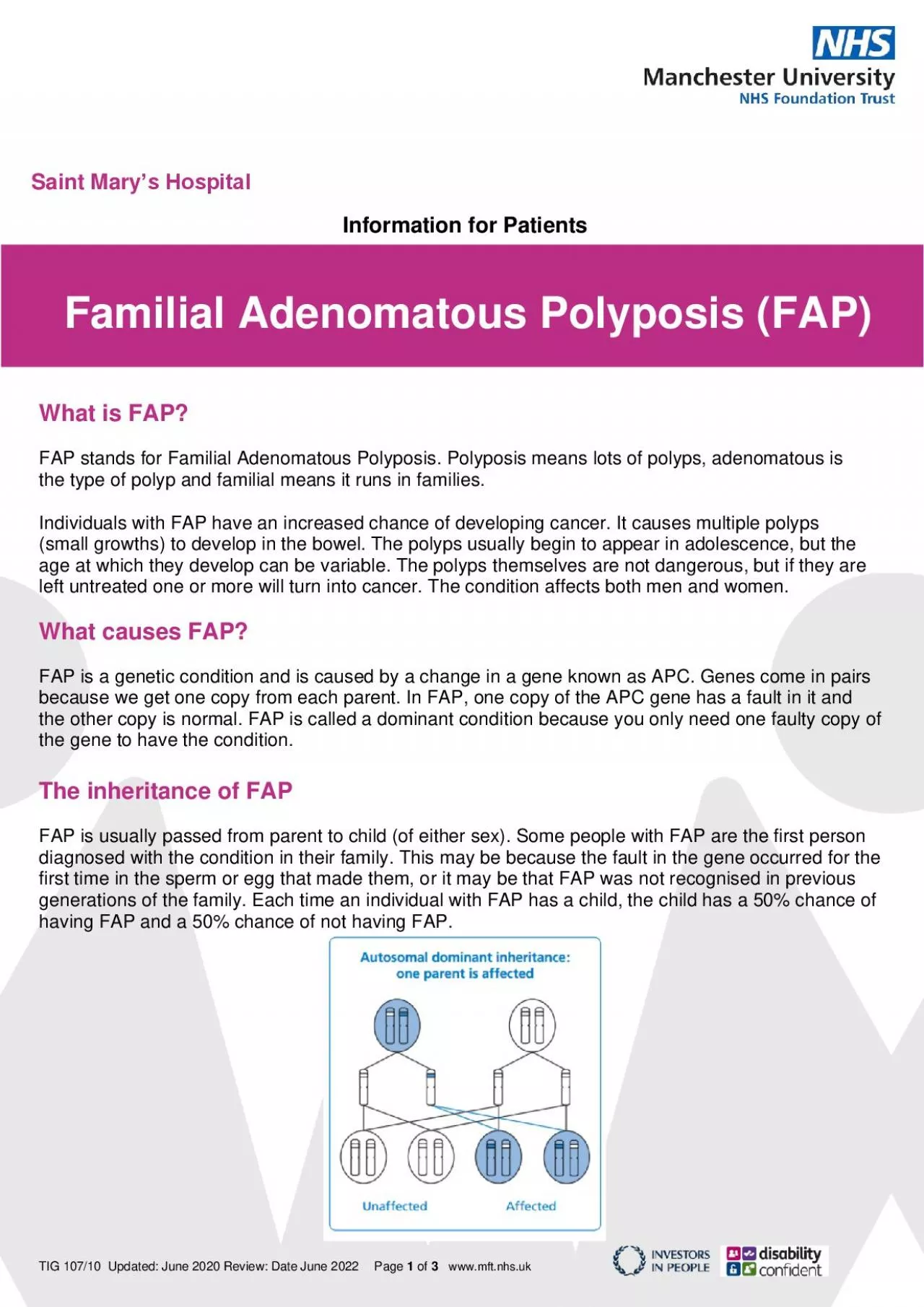

Sain t Mary Information for Patients Familial Adenomatous Polyposis FAP What is FAP the type of polyp and familial means it runs in fa milies Individuals with FAP have an increased chance of devel ID: 954476
Download Pdf The PPT/PDF document "s Hospital" is the property of its rightful owner. Permission is granted to download and print the materials on this web site for personal, non-commercial use only, and to display it on your personal computer provided you do not modify the materials and that you retain all copyright notices contained in the materials. By downloading content from our website, you accept the terms of this agreement.
Sain t Mary ’s Hospital Information for Patients Familial Adenomatous Polyposis (FAP) What is FAP? the type of polyp and familial means it runs in fa milies. Individuals with FAP have an increased chance of developing cancer. It causes multiple polyps (small growths) to develop in the bowel. The polyps usually begin to appear in adolescence, but the age at which they develop can be variable. The polyps left untreated one or more will turn into cancer. The condition affects both men and women. What causes FAP? FAP is a genetic condition and is caused by a change in a gene known as APC. Genes come in pairs the other copy is normal. FAP is called a dominant condition because you only need one faulty copy of the gene to have the condition. The inheritance of FAP FAP is usually passed from parent to child (of either sex). Some people with FAP are the first person first time in the sperm or egg that made them, o r it may be that FAP was not recognised in previous generations of the family. Each time an individual with FAP has a child, the child has a 50% chance of having FAP and a 50% chance of not having FAP. TIG 107/10 Updated: June 2020 Re view: Date June 2022 Page 1 of 3 www.mft.nhs.uk Genetic testing for FAP We can look for the exact APC gene fault which has caused FAP if we have a blood sample from a person who has the condition. In different families, there are different mistakes in the gene. If we know the mistake in the family, we can look just for that. If you are the first person to have FAP or we don ’t know the mistake inn your family, we can look through the whole gene for a mistake. We can ’t always find the mistake, but we do i n most people (80%) of tho
se with FAP. Family members of a person with FAP It is helpful to know if relatives of a person with FAP will develop the condition, so they can have the right medical management. If the exact gene fault is known in a family, th en we can offer a blood test to relatives to see if they have inherited FAP. The test is available from 10 years of age because polyps usually start growing around puberty. Alternatively (or if the gene fault has not been identified) a camera examination of the bowel (colonoscopy) can be carried out to look for bowel polyps. The frequency of screening depends on whether polyps are found in the bowel. Management and treatment for FAP People with FAP need to have a camera examination (colonoscopy) of the bowel every 1 - 3 years to monitor the number and size of polyps. Initially, polyps can be removed during this examination, but as their number increases this becomes too difficult. Eventually, planned surgery to remove the large bowel is required to prev ent cancer. Sometimes this means using a temporary bag (stoma), but this is rarely permanent. Normal bowel function is often regained after surgery. Polyps can also grow in the stomach and the duodenum (the exit from the stomach). These polyps are much le ss likely to turn into cancer. These polyps need to be checked every 3 - 5 years from the age of 30. This is done by a camera examination down the throat. Other features of FAP There are a few other features that are associated with FAP, such as extra spot s of pigment at the back of the eye and bony lumps on the jaw, but these usually go unnoticed and do not cause any problems. There are some other medical problems associated with FAP. These are rare and do not happen often. These include non - cancerous sof t t
issue tumours, desmoid tumours (specific non - cancerous tumour seen in connective tissue), and associated cancers such as thyroid cancers. If you have questions about these please talk to your genetics clinician. Attenuated FAP Some families with FAP h ave fewer polyps and these develop later in life. This is called attenuated FAP. It is inherited in the same way as classical FAP but means less frequent screening is necessary, and it can often start at a slightly older age. TIG 107/10 Updated: June 2020 Review: Date June 2022 Page 2 of 3 www.mft.nhs.uk Additional Support There are two main UK patient Support groups: The FAP Gene Support Group: http://www.fapgene.com/ who also run a closed facebook page. P olypeople attached to St Marks in London and for all polyposis conditions including FAP: www.polypeople.online For more information If you need more advice about any aspect of FAP, you are welcome to contact: Manchester Centre for Genomic Medicine Sixth Floor Saint Mary ’s Hospital Oxford Road Manchester M13 9WL Telephone: (0161) 276 6506 (Reception) Department staffed Monday – Friday, 9.00 am to 5.00 pm. Website: www.mangen.co.uk Please let us know if you woul d like this leaflet in another format (e.g. large print, Braille, audio). Seen in clinic by (doctor): __________________________________________________ And (Genetic Counsellor): __________________________________________________ Telephone number: ___ ____________________________________________________ Family reference number: __________________________________________________ TIG 107/10 Updated: June 2020 Review: Date June 2022 Page 3 of 3 www.mft.nhs.